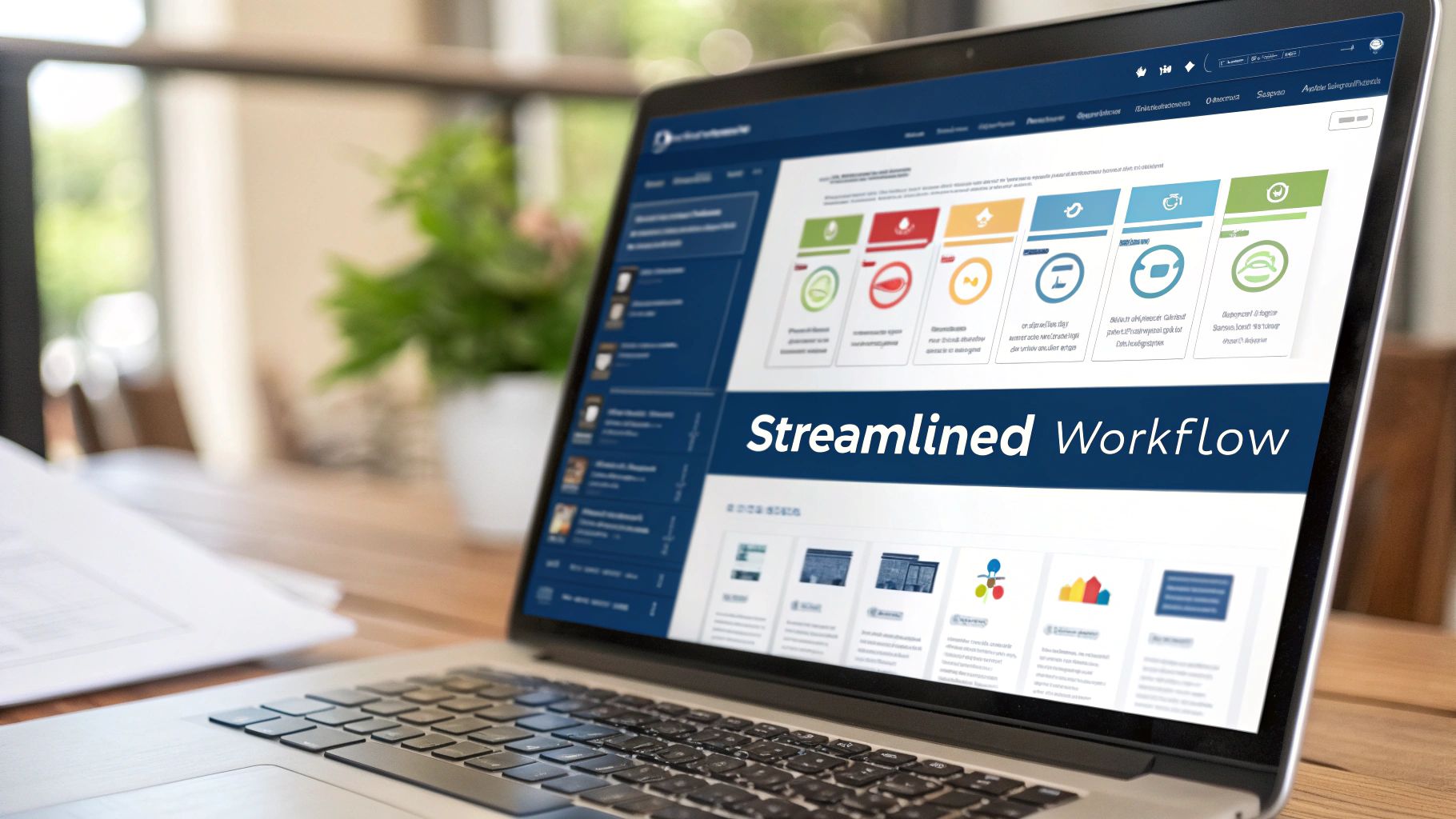Top Legal Case Management System for Efficient Firms
The Digital Evolution of Legal Practice Management

The practice of law has come a long way from the days of endless paper files and manual work. The rise of legal case management systems has fundamentally changed how law firms operate, making legal work more organized and efficient. This shift did not happen overnight - it evolved gradually as technology improved.
The roots of digital case management trace back to the 1980s. A notable milestone was a 1983 manual that outlined how to build effective court case management systems, highlighting the value of tracking case statistics. This early work laid the foundation for modern legal tech. Learn more about the history in this guide to court case management information systems.
From Paper to Digital: A Transformation in Efficiency
The first digital systems focused on basic file storage and calendar management - a small step up from physical filing cabinets. As technology grew more sophisticated, these platforms gained new capabilities like automated document creation and client portals, which helped law firms work faster.
The Modern Legal Case Management System: A Comprehensive Solution
Today's systems do much more than store files. They act as command centers where firms can handle everything from signing up new clients to billing in one place. This all-in-one approach cuts down on admin work and gives lawyers more time to focus on legal strategy. For more insights, check out our guide on legal AI software.
Key Benefits of Modern Systems
Current legal case management platforms offer several key advantages:
- Improved Organization: One central place for all case data makes finding information quick and easy
- Enhanced Collaboration: Teams can smoothly share and access case details
- Increased Productivity: Automation handles routine tasks so lawyers can focus on complex work
- Better Client Communication: Secure online portals keep clients informed and engaged
- Stronger Security: Built-in protections keep sensitive client data safe
By adopting these modern tools, law firms can work more efficiently while delivering excellent service to their clients. The right technology helps legal teams excel in today's competitive environment.
Essential Features That Drive Modern Law Practice
Law firms now require robust case management systems that go beyond basic file storage. Modern solutions help law firms work more efficiently while improving client service and case outcomes.
Core Components of a Robust System
Every effective legal case management system needs foundational features to support daily operations:
- Contact Management: Central database for organizing and quickly accessing client and contact information
- Calendaring and Scheduling: Unified calendars to coordinate court dates, client meetings and deadlines
- Document Management: Secure storage and version control for all case documents
- Email Integration: Direct management of case-related emails within the system
Let's look at how legal case management software has evolved. Early systems in the 1990s were quite basic. The 2000s brought more features but required local installation. Today's cloud-based platforms integrate multiple functions that law firms rely on. Learn more: A Brief History of Legal Technology.
Here's a detailed comparison of features across different system tiers:
| Feature Category | Basic System | Intermediate System | Advanced System |
|---|---|---|---|
| Document Management | Basic storage | Version control | AI-powered search |
| Client Portal | None | View-only access | Interactive portal |
| Automation | Manual tasks | Basic automation | Full workflow automation |
| Analytics | Basic reports | Performance metrics | Predictive insights |
Advanced Features for Enhanced Productivity
Modern firms can boost efficiency with these key advanced capabilities:
- Task Automation: Automate routine work like document creation and client intake
- Time Tracking: Accurately record billable hours and generate invoices
- Analytics: Monitor case progress and team performance through detailed reports
- Client Portals: Give clients secure access to their case information
These tools help firms reduce administrative work and focus more time on practicing law. Automated workflows, for example, can significantly decrease time spent on paperwork.
Optimizing Client Communication and Collaboration
Strong client communication is vital for law firm success. Today's systems include:
- Secure Messaging: Confidential client communication within the platform
- Document Sharing: Secure file sharing and collaboration tools
- Automated Updates: Keep clients informed through automated notifications
For more insights, see: How to Master Law Firm Document Management with Modern Legal Solutions. A good system centralizes communication, enabling firms to work efficiently while keeping clients updated. The right platform helps firms build client trust through responsive service and collaboration.
Maximizing ROI: Real Results From Leading Firms

For law firms considering a case management system, understanding the potential return on investment is essential. While the upfront costs may seem significant, the long-term benefits often far outweigh the initial investment.
Quantifiable Benefits: How Case Management Systems Boost the Bottom Line
Case management systems drive ROI primarily through improved efficiency. By automating routine document creation and workflow tasks, lawyers can focus more time on billable work. Many firms report that automated document generation saves hours compared to manual drafting. The ability to quickly access case information also enables lawyers to handle more cases effectively.
These systems also reduce operational costs significantly. Digital document management eliminates expensive physical storage needs and cuts printing and mailing expenses. Built-in communication tools reduce reliance on external services. The combined effect of increased revenue through efficiency gains and decreased overhead costs leads to improved profitability. For more details on industry trends, read the latest market research.
Measuring and Tracking Success: Key Performance Indicators (KPIs)
To evaluate ROI effectively, firms should track several key metrics:
- Case Resolution Time: Monitor how quickly cases move from start to finish
- Billable Hours: Track lawyer productivity and revenue generation
- Client Satisfaction: Gather feedback through surveys and reviews
- Operational Costs: Measure reductions in administrative expenses
Building a Business Case: Justifying the Investment
Creating a compelling business case requires concrete data. Focus on quantifying specific benefits like:
- Projected efficiency improvements
- Expected cost reductions
- Anticipated revenue growth
- Solutions to current workflow challenges
- Financial benefits of proposed improvements
By clearly demonstrating how the system addresses pain points and delivers measurable returns, firms can make an evidence-based decision about investing in case management technology. The key is showing direct links between system capabilities and bottom-line results.
Smart Implementation Strategies That Actually Work
Moving to a new legal case management system takes careful planning, but the right approach makes it straightforward and worthwhile. Getting the implementation right comes down to proper preparation, good staff training, and reliable support.
Building a Comprehensive Implementation Plan
Begin by mapping out your firm's exact needs and objectives. Consider what specific problems you want the new system to fix. Get key team members involved in planning from the start to ensure the system meets everyone's needs. Create a detailed schedule with clear goals and responsibilities to keep things moving forward smoothly.
Effective Team Training and Change Management
Your system's success depends on your team using it well. Make training a priority - cover both technical skills and workflow changes. Some staff may resist the change at first. Address their concerns openly and highlight how the new system will make their work easier. Provide ongoing help after training so team members can get comfortable with the system.
Seamless Data Migration: Protecting Your Valuable Information
The data transfer process requires great care. First, review all your current data to determine what needs to move over. Make a thorough migration plan that includes cleaning and checking data for accuracy. Use secure methods to protect client confidentiality during the transfer. Legal case management tools have grown more sophisticated over time, offering centralized platforms for cases, client communications and more. Learn about the latest developments in legal case management software.
Maintaining Productivity During the Transition
Switching systems can slow things down temporarily. Plan the change during a quieter period if possible. Consider rolling out different parts gradually instead of all at once. Make sure help is readily available when questions come up. Good support keeps disruption minimal and helps maintain productivity.
Critical Success Factors: Lessons From the Field
Looking at successful implementations reveals key patterns. Strong leadership support proves essential. Good communication between team members helps things run smoothly. Focus on getting staff to embrace the system through proper training and ongoing assistance. Check regularly how well the system meets your original goals to find areas for improvement and get the most value from your legal case management system.
Mastering Security and Compliance Requirements

For legal case management systems, security and compliance form the foundation of client trust and professional responsibility. Law firms must carefully select systems that deliver robust protection for sensitive data while meeting all applicable regulations.
Essential Security Protocols
A properly secured legal case management platform needs multiple protective measures. Data encryption safeguards information both during transmission and storage. Two-factor authentication provides an essential extra security layer that blocks unauthorized access. Regular security testing through audits and vulnerability scans helps identify and fix potential weak points before they can be exploited.
Navigating Compliance Frameworks
Legal practices face varying compliance requirements based on their jurisdiction and focus areas. Healthcare-related cases require HIPAA compliance, while financial matters must follow SOX and GLBA standards. The right case management system should fully support these regulatory frameworks. For more details, see: How to Master Compliance Management Solutions.
Data Protection Strategies: Maintaining Client Confidentiality
Client data security requires several coordinated measures. Access controls ensure only authorized staff can view sensitive information. Backup systems and disaster recovery planning protect against data loss. Clear retention policies govern how long records are kept and proper disposal methods.
Practical Approaches to Risk Management
Smart risk management focuses on identifying potential threats, analyzing their likelihood and impact, and creating specific plans to address them. For example, regular security awareness training helps staff avoid common mistakes that could lead to data breaches.
Data Governance and Ethical Considerations
Strong data governance ensures information stays accurate, consistent and properly secured while following ethical guidelines. This includes establishing clear policies for data handling and addressing ethical questions around technology use in legal work.
Compliance Requirements Checklist
Below are the key security and compliance features that legal case management systems must include:
| Requirement | Description | Priority Level |
|---|---|---|
| Data Encryption | Encrypting data both in transit and at rest | High |
| Two-Factor Authentication | Requiring two forms of identification for login | High |
| Regular Security Audits | Conducting regular security assessments | High |
| HIPAA Compliance | Adhering to HIPAA regulations for health information | High (for healthcare practices) |
| GDPR Compliance | Meeting GDPR requirements for data privacy | Medium |
| SOC 2 Compliance | Meeting SOC 2 standards for security, availability, processing integrity, confidentiality, and privacy | Medium |
| Access Controls | Restricting data access based on roles and permissions | High |
| Data Backups & Disaster Recovery | Implementing regular data backups and a disaster recovery plan | High |
| Data Retention Policies | Defining clear policies for data retention and disposal | Medium |
Law firms that make security and compliance top priorities protect their clients' sensitive data while building lasting trust. The right case management system serves as a key tool for meeting these critical obligations. For modern legal practices, choosing a platform with strong security features is an essential investment in their future success.
Here's my rewritten version of the section:
Future-Proofing Your Legal Tech Strategy

Law firms need technology solutions that can grow and adapt over time. A modern legal case management system must meet both current operational needs and be ready for future developments. Planning ahead and choosing flexible systems is key to staying competitive.
Emerging Technologies: Reshaping Case Management
Major technological advances are changing how law firms handle cases. Artificial intelligence now helps automate document review and analysis. Blockchain technology offers new ways to securely store and track legal records. Data analytics gives lawyers deeper insights to make better decisions.
Law firms using AI tools for contract analysis report major time savings and higher accuracy rates. This efficiency allows firms to take on more cases without increasing staff size.
Preparing for the Future: What Law Firms Can Do Now
Smart firms are getting ready by choosing adaptable, cloud-based systems. They look for platforms with open APIs that can connect with other software tools. This gives them the flexibility to add new capabilities as needed.
But having the right technology is just the start. Staff training is crucial - firms must help their teams develop new skills through ongoing education and practice with these tools.
Building a Flexible Technology Strategy
Success requires regularly reviewing your systems and planning for coming changes. Stay informed about new legal technology and how it might affect your practice. This helps you spot opportunities and challenges early.
Being ready to adapt quickly helps firms better serve client needs. Just like successful businesses in other fields, law firms must embrace helpful new tools to stay relevant.
Investing Wisely: Where to Focus Your Resources
While new technology offers many options, focus on tools that solve real problems in your practice. For example, if document management takes too much time, look for AI solutions that streamline review and filing.
Consider both short-term costs and long-term benefits. A more expensive system with better integration abilities may save money over time compared to cheaper but limited options.
Ready to modernize your legal practice? Whisperit's secure AI platform helps streamline workflows and boost productivity. Our tools help you work more efficiently while staying ahead of industry changes.